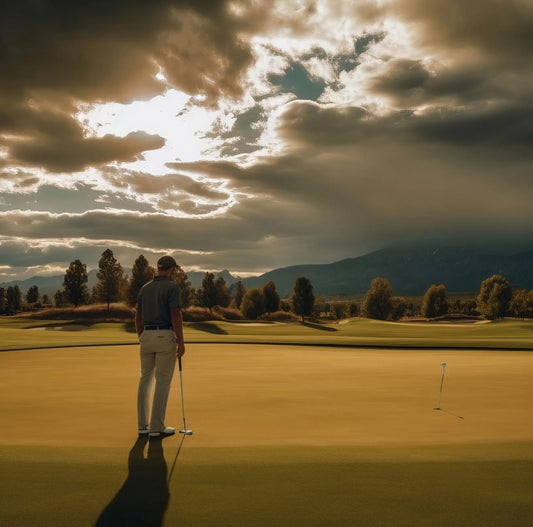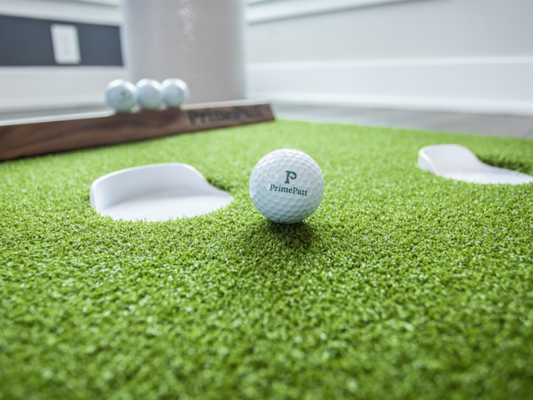When it comes to golf, we all love a good challenge, but the effects of adverse weather can give you a brutal disadvantage. Wind, rain, or shine, the weather can impact the conditions of the course, your strategy and ability to score, the greens, and, perhaps most frustrating of all, your putting.
Even though golfers can be some of the most prepared individuals when it comes to daily weather conditions, it’s still important to learn how those adverse conditions can impact your swing, ball flight, and overall game.
This article will outline what weather conditions to look out for and how you can adjust. Understanding how the weather can impact both course conditions and your putting is key to bringing consistency into your game, regardless of how much effort you otherwise put into your practice.
How Can Mother Nature Impact Putting?
Weather can alter not only the condition of the putting green, but also your stroke. These are the factors to pay attention to:
The Impact of Weather on Grass
Depending on where you play, various kinds of grass could affect your experience on the course. The type of grass capable of thriving in cooler temperatures wouldn’t survive in the scorching heat. Conversely, areas like the desert with dry air aren't going to be able to nurture and grow the same type of grass as a locale with 100% humidity.
These different types of grass react independently of one another when playing golf. Specifically as it relates to putting, alterations will need to be made to how you might read greens, anticipate the speed of a putt, and even the way in which you stroke the ball. All putting greens are not created equal, and you have to be able to adapt to their many variations in the moment.
Weather Patterns
There are a few major weather patterns to consider in your quest to tackle different course conditions. Hopefully, you'll leave here with a little more knowledge than when you started, allowing you to adapt to any putting green you play on.
High Winds
Wicked winds can not only affect the condition of the putting greens you are playing on, but also the overall structure of your putting stroke. This weather condition has more impact on your golf game than perhaps any other.
You may have seen the infamous LPGA and PGA Tournaments in Hawaii; the winds on the islands can be unlike anything you've ever seen. They cause flag sticks to bend nearly to the point of breaking. Winds have even gotten so high as to result in a delay of play or even the postponement of a round until the winds die down and course conditions become playable again.
Wind can dry out the putting green, causing it to become firm, which also increases the green speed and makes it faster as the day goes on. This one-two punch of firm and fast can be a lethal combination for your game on a windy day.
Getting your ball to stay at rest on the putting surface becomes an art and a science—an almost impossible task if the putting greens you are playing on are well-manicured, not to mention standing up! The inability to keep your putting stance stable, in addition to your putter being blown around throughout your putting stroke, can lead to a very frustrating trip around the golf course.
Generally, wind is one of the hardest weather conditions to play in because it amounts to a complete and total guessing game. There is no way to measure the exact speed of the wind at the exact moment you are going to be putting, so trusting yourself becomes a crucial part of your performance. Succeeding in these kinds of conditions boils down to one simple fact: if you believe in yourself, you'll always make a better stroke than if you have all the numbers but hesitate when it's time to play.
Even so, there are some technical things to consider on windy days. Putting into the wind will slow a putt down significantly, forcing you to make a harder strike. The exact opposite happens when putting downwind. You need to be more delicate so the putt doesn’t run away from you, especially if you are putting downhill and downwind.
Pro tip: A good rule of thumb when it’s windy and you are on a putting green is to widen your putting stance to outside shoulder width. This allows your lower body to serve as a more stable base, counteracting the wind as it tries to blow you and the arc of your stroke off-balance.
Heavy Rain and Humidity
Heavy rain will do the opposite of high winds. Wet putting greens slow down and become very soft. Some putting greens can only take in so much water before they start to pool and create puddles, inevitably becoming unplayable. Rain isn’t the only time you may experience moisture on the golf course, though.
If you live in Florida, you know exactly what we’re talking about. In humid climates, especially in the morning, there can be a significant layer of dew on the greens. Early morning golfers are known as dew sweepers for a reason! They experience the same collection of water on the golf ball while putting as you would if it was actively raining.
Pro tip: When there is water sitting on the surface of a putting green, putts need to be hit much harder. As the ball rolls towards the cup, it starts to collect water along its path, losing speed exponentially faster than it typically would in drier conditions.
Cool Temperatures
Bent grass is one of the specific types of grass that thrives in cooler temperatures. It is a grass without grain that produces a much truer roll due to the lack of deviation from the direction the grass is growing.
Cooler temperatures, though, can also make it harder to compress the golf ball, making the action of hitting the ball feel much heavier than usual. As it relates to putting, this effect can significantly impact your ability to have good speed control. The reason is that when a golf ball gets cold, it feels harder, and most golfers will want to hit a putt harder as a result. The impact won’t feel as soft or solid as it normally would, so we tend to overcompensate as we search for that feeling.
Pro tip: Being aware of this environmental change and how it can affect your putting may save you the headache of multiple 3-putts the next time you play in a cooler climate.
Drought
Drought can cause a similar effect on the putting surface as high winds but without the annoyance of the actual wind on top of the firm and fast greens.
When there is a drought, golf course superintendents have to be strategic about where, when, and how often they water different parts of the course. Because of this, saturating the putting greens in an effort to have more receptive surfaces at more manageable speeds might not be a sustainable option.
During a drought, greens become much faster and firmer, making putting even more difficult than it already is. At the extreme end of green firmness, you might not be able to tell the difference between putting on an indoor putting mat or a real putting green. You may also find that the green speeds are more aggressive than you are used to in situations where you have more control.
Pro tip: During a drought, grasses are particularly prone to traffic damage. In order to keep courses healthy, avoid walking or driving over brown spots.
Scorching Heat
Immense heat is the polar opposite of cool temperatures. Because golf balls compress better at higher temperatures, contact when putting may feel softer than normal, leading you to think you may not have to strike it as hard. Consistency in reading the green and speed control can be tough to achieve as a result.
Imagine you are in a region that has cool-weather grass and cooler temperatures but is suddenly experiencing an abnormal heatwave. The course maintenance crew may need to periodically apply a light film of water throughout the day in order to ensure the putting greens don’t burn out, also known as syringing.
They do have to be careful not to overwater because water conducts heat. If a putting green is oversaturated in scorching temperatures, it can cause the roots of the grass to overheat and cook, severely damaging the putting green. Remember: golf course maintenance is a constantly moving target with plenty going on behind the scenes, even if it appears to be a perfectly mild and sunny day.
Pro tip: It may seem like a no-brainer, but it’s crucial that you stay hydrated and find shade as much as possible while golfing in extreme heat. Dehydration and exhaustion could have adverse effects on your body, mental focus for the game, and overall ability to play consistently.
Weather Can Impact More Than Just Your Putting
When Mother Nature rears her ugly head, she can change course conditions in an instant, causing the course you played yesterday to feel like a completely different track today. Think about the above weather conditions and how they affect a putting surface. Imagine hitting approach shots on those greens in each of those scenarios.
Having highly receptive greens due to oversaturation from rain could lead to a low round because you can fire at flag sticks and know that the greens will hold better. Hitting approach shots into firm and fast greens, on the other hand, could result in a much higher score than usual. Holding greens may become a far-fetched idea on courses experiencing a drought or in an area with predominantly strong winds as an everyday weather pattern. These courses might demand a more links-style approach where the goal is to land the ball short of the green and let it roll up.
Understanding how the weather might impact course conditions is as important as the work you put in on the driving range or practice putting green. It's useful to think of course management as just another important "club" in your bag that many good players lose sight of.
Do yourself a favor and check the weather before your next golf trip. Know what the weather will be like in the days leading up to your rounds so you can have a better understanding of the course conditions you will face.
How Can I Prepare for Unexpected Course Conditions Due to Weather?
In a word, practice. The more you practice, the better you get. This can be said for anything in life, but especially when it comes to golf. If you have the opportunity to practice in different conditions, take advantage of it. If the range is open on a rainy day (though not a thunderstorm), get out and hit a few instead of chalking it up to an automatic day off!
A great way to practice your putting for firm green conditions is on an indoor putting mat. With tile or wood flooring underneath the mat you are putting on, the speed will be much faster than most natural putting greens, making it a great way to prep for those slick greens.
If time or money is keeping you from working on your game or even just your putting, there are always alternatives. Indoor putting mats, for instance, have come a long way in their ability to mimic tour-grade turf. A commitment to practicing, whether it is in your living room on an indoor putting mat or at the practice facility of your local golf course, is the only way you're going to see lasting progress in your game—no matter the weather.
FAQs
Can the weather really impact golf course conditions?
Yes. Unexpected weather can cause a golf course to play much differently than you are used to. Imagine a desert course with firm, fast fairways that experiences rain for multiple days in a row. You may be used to getting rollout, and after a few days of rain, the golf course plays much longer as a result of no rollout from your tee shots.
How will the weather affect my putting?
The weather can affect it in a multitude of ways. Depending on the amount of moisture in the air, putting greens can play either slower or faster. Greens can get much faster when it is dry and windy, affecting your ability to have good speed control. Wet greens play much slower, forcing you to hit putts much firmer than you may be used to.
Can the weather cause course conditions to change drastically from one day to the next?
Yes! The weather can cause course conditions to change dramatically not only from one day to the next, but also within hours, depending on the severity of the weather.





